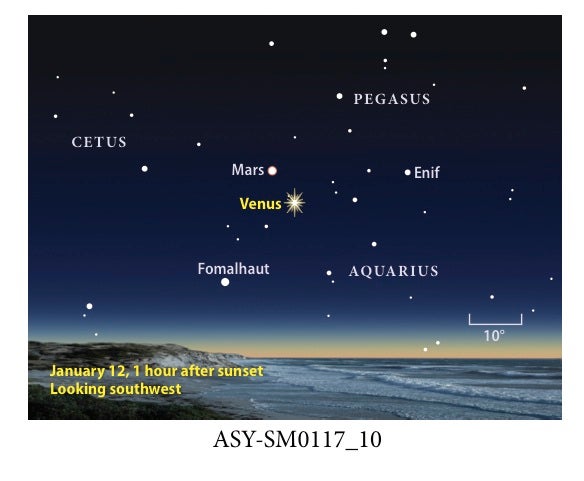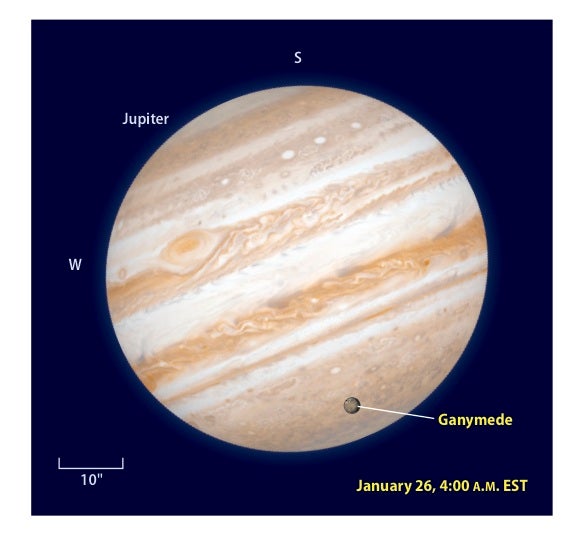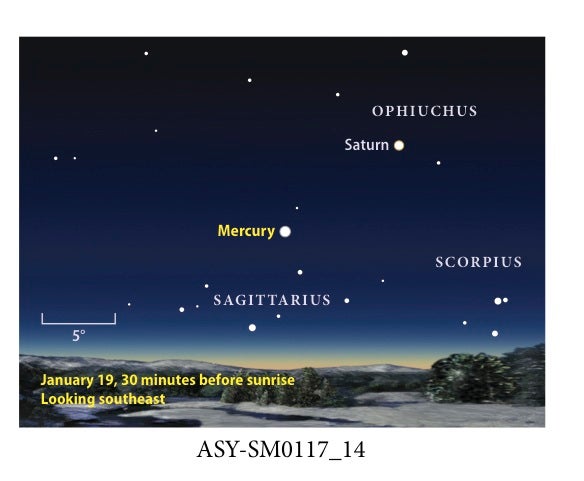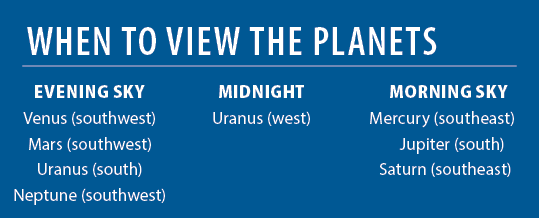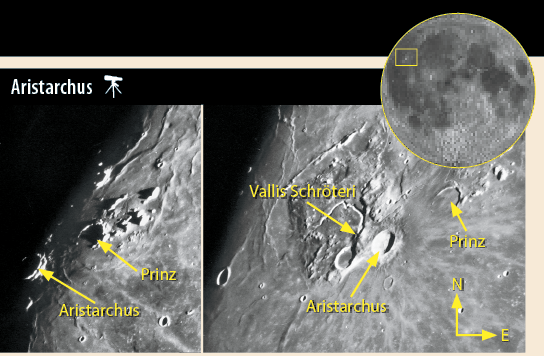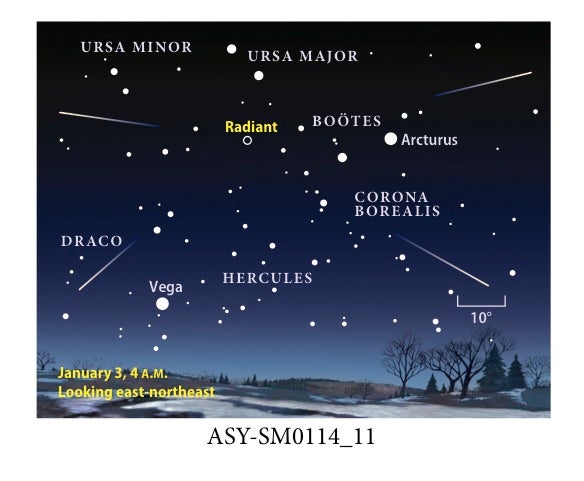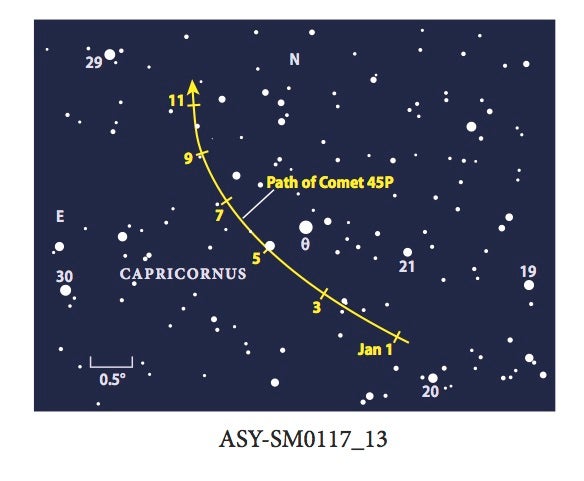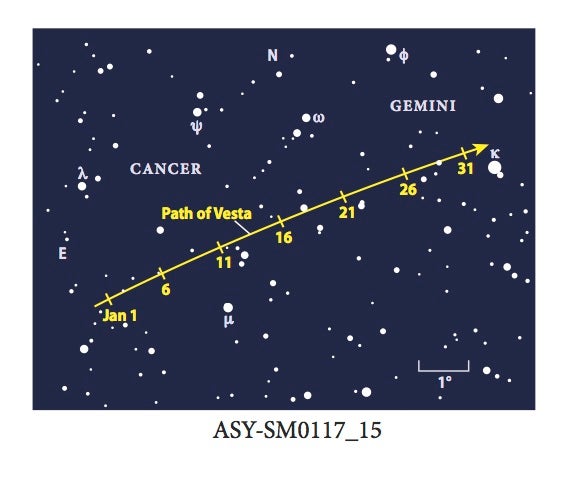Let’s start our tour of the sky as darkness descends New Year’s Day. A lovely four-day-old Moon first grabs your attention. The 13-percent-lit crescent — with the ashen glow of earthshine faintly illuminating the “dark” side — stands 25° above the southwestern horizon an hour after the Sun sets.
A quick glimpse of the Moon also reveals Venus 5° to the upper left. The inner world shines at magnitude –4.4, far brighter than any other point of light in the sky. The planet resides in Aquarius, as do its solar system cousins Mars and Neptune. Mars glows at magnitude 0.9, less than 1 percent as bright as Venus, and lies 12° to the brighter world’s upper left. Magnitude 7.9 Neptune appears 630 times dimmer still. You can spot it through binoculars just 0.5° to Mars’ lower right. By the evening of January 2, the waxing crescent Moon hovers between Venus and Mars.
Venus is in the midst of its finest evening show in five years. It reaches greatest elongation January 12, when it lies 47° east of the Sun. It then appears 30° above the southwestern horizon an hour after sundown and doesn’t set until 9 p.m. local time. Even better, it pretty much maintains this evening altitude all month.
The inner planet moves eastward relative to the background stars during January. It begins the month in south-central Aquarius and crosses into western Pisces on the 23rd. Venus spends the remainder of the month skimming south of the Fish’s Circlet asterism. A waxing crescent Moon pays a second visit to this vicinity January 31, when it forms a tight, photogenic triangle with Venus and Mars. By then, Venus has brightened to magnitude –4.7 while Mars has faded to magnitude 1.1.
A telescope reveals rapid changes on Venus this month. On the evening of January 1, the planet appears 22″ across and 56 percent lit. Two days after greatest elongation, on the 14th, precisely half of the world’s 25″-diameter disk appears illuminated. And on January’s final evening, Venus spans 31″ and shows a 40-percent-lit phase. The best views come in late twilight, when the planet lies higher and its contrast with the sky is more muted.
Mars remains easy to find throughout January. The 1st-magnitude planet shines brighter than any nearby star, and its obvious orange-red hue stands out from the mostly colorless objects that surround it. It also doesn’t hurt to have brilliant Venus lying a stone’s throw to its lower right. Mars lies in Aquarius until the night of January 18/19, when it crosses into Pisces.
Despite its prominence in the evening sky, Mars proves disappointing when viewed through a telescope. The planet spans a mere 5.4″ at midmonth and shows little, if any, surface detail. Its most noticeable aspect is a gibbous phase, which waxes from 90 to 92 percent illumination during January.
Let Mars serve as a guide for finding Neptune. On January 1, the ice giant lies 0.5° (the diameter of a Full Moon) west-southwest of Mars. If you aim your binoculars toward the Red Planet, the brightest object to its immediate lower right will be magnitude 7.9 Neptune. (As a reminder, the two planets passed less than 10′ from each other on New Year’s Eve.)
The gap between the two grows about 0.7° each day. But Neptune has a second dramatic encounter in store. On January 12, Venus passes 0.4° due north of the distant world.
Neptune moves much more slowly relative to Aquarius’ stars. You can use magnitude 3.7 Lambda (λ) Aquarii to home in on the planet’s location throughout January. On the 1st, Neptune lies 2.1° southwest of this star, and it closes to within 1.3° by the 31st. As always, you can tell the planet from a star by viewing it through a telescope at medium power. Only Neptune shows a disk, which measures 2.2″ across and has a subtle blue-gray color.
When Venus and Mars move into Pisces in the latter half of January, they join long-term resident Uranus, which has been swimming with the Fish since 2013. The planet lies more than halfway to the zenith in the south-southwest as darkness falls and doesn’t set until around midnight local time. Uranus shines at magnitude 5.8, which is bright enough to show up to the naked eye from dark-sky sites and an easy target through binoculars from the suburbs.
To find the planet, start at magnitude 5.2 Zeta (ζ) Piscium. Uranus stands 0.6° east of Zeta as January begins and moves to a point 1.0° east of the star by the end of the month. You can confirm a planet sighting by targeting it through a telescope. Uranus displays a 3.5″-diameter disk and a striking blue-green color.
Jupiter dominates the morning sky throughout January. It rises around 1 a.m. local time on the 1st and some two hours earlier by the 31st. It appears among the background stars of Virgo, 4° north of the Maiden’s luminary, 1st-magnitude Spica. (Jupiter passes due north of Spica on January 20.) At magnitude –2.0, however, the planet appears 16 times brighter than the star.
Jupiter climbs highest in the south around the time twilight starts to paint the sky. This is the best time to target the gas giant through a telescope because the greater altitude means the planet’s light traverses less of Earth’s turbulent atmosphere. Jupiter’s disk spans 37″ at midmonth and displays a dynamic atmosphere highlighted by two dark cloud belts sandwiched around a brighter zone that coincides with the planet’s equator.
A telescope also reveals Jupiter’s four Galilean moons. If you don’t see four, it means that one or more of them is passing either in front of or behind the planet. It’s a treat to watch a moon or its dark shadow cross in front of Jupiter. And with the planet up for several hours each morning, North American observers have plenty of opportunities to witness such transits.
The first well-timed event occurs January 6, when the shadow of Io transits Jupiter beginning at 5:24 a.m. EST. The moon itself starts crossing the planet’s disk at 6:37 a.m. Both transits last a little longer than two hours. On January 15, Io’s shadow hits the gas giant’s cloud tops starting at 1:45 a.m. EST while the moon follows 1 hour and 14 minutes later.
As Jupiter rises January 11, Europa appears in transit. The smallest of the Galilean satellites departs the planet’s disk at 3:31 a.m. EST. The same moon puts on a full show on the 18th. Europa’s shadow first appears on Jupiter’s disk at 1:12 a.m. EST. The shadow lifts back into space at 3:42 a.m., just one minute after Europa itself begins a transit on the planet’s opposite limb.
If Earth were in the plane of the moons’ orbits, an occasion that occurs every six years or so, all satellite transits would track across Jupiter’s equator. We are now 3° out of this plane, and you can see the result by observing the outer two moons, Ganymede and Callisto. Watch Ganymede cross the north polar region of the planet January 26 from 2:55 a.m. to 5:02 a.m. EST. Callisto orbits even farther away and doesn’t even transit the gas giant. You can find this moon south of the planet the morning of January 22.
The new year initiates a new observing season for Saturn. The ringed world rises 90 minutes before the Sun on January 1 and three hours before our star on the 31st. The gas giant shines at magnitude 0.5 and stands out in the southeastern sky as dawn approaches. It lies against the backdrop of southern Ophiuchus, but it is far brighter than any of the Serpent-bearer’s stars. Watch as a waning crescent Moon passes 4° north of Saturn the morning of the 24th.
The best time to view the ringed planet through a telescope comes late in the month, when it climbs highest before dawn. Saturn then shows a 16″-diameter disk with a ring system that spans 35″ and tilts 27° to our line of sight.
Our final planet comes into view once twilight commences. Mercury peaks when it reaches greatest elongation January 19. It then lies 24° west of the Sun and stands 10° above the southeastern horizon a half-hour before sunrise. It shines at magnitude –0.2 — as it does throughout January’s second half — and appears obvious in twilight.
Swing a telescope toward Mercury and you’ll see rapid changes in its appearance this month. On January 14, the inner planet shows a disk that spans 7.4″ and is exactly half-lit. By the 31st, Mercury’s diameter has dwindled to 5.7″ while its phase has waxed to 80 percent lit.
The brilliance of Luna’s brightest crater
“There’s something happening on the Moon!” For a long-dead world like Earth’s satellite, anything that looks unusual quickly draws attention, and a striking blaze of flickering light along the terminator certainly does the trick. Lunar observers have a chance to experience this thrill the evening of January 8, when the Sun illuminates the brilliant western flank of Aristarchus. Earth’s turbulent atmosphere may add some colorful scintillation to produce an even more memorable sight.
For a few minutes, forget that the Moon’s volcanoes went extinct long before dinosaurs roamed Earth and enjoy a simulation of an eruption at Aristarchus Crater. Once sunlight starts to illuminate the crater’s western flank, the drama unfolds over a few hours as more of the rim appears and the inner walls light up. (Observers in eastern North America will have to wait until late evening for the show to begin.) Generation after generation of smart, sharp-eyed astronomers managed to convince themselves that the changing light was a sign of lunar activity.
One evening later, look for a diamond-shaped plateau protruding above the surrounding lava-flooded plain. Just west of the blazing crater, notice the long snakelike Vallis Schröteri (Schröter’s Valley). A massive lava flow that would have dwarfed anything ever seen on Earth carved out this 6-mile-wide channel. The valley stops near Aristarchus at a shadowed volcanic vent in a wider zone aptly named the “Cobra’s head.”
Aristarchus reflects so much light that it shows up easily even under the faint illumination of earthshine. Just after New Moon on January’s first few evenings, most of Luna’s nearside has turned away from the Sun, and our satellite appears as a thin crescent. But this hemisphere faces an almost fully lit Earth, which bathes the dark expanse in an ashen light. Aristarchus stands out through a telescope as a bright patch in the Moon’s northwestern quadrant.
Ideal conditions for a New Year’s show
Lots of fiery streaks should light up the sky when the Quadrantid meteor shower reaches its peak before dawn January 3. The waxing crescent Moon sets before 10 p.m. local time the previous evening, promising dark skies during the prime viewing hours after midnight. As long as the weather cooperates — no certainty in early January — observers under a dark sky could see up to 120 meteors per hour.
The meteors appear to radiate from a point in northern Boötes. This is the site of a now-defunct constellation named Quadrans Muralis, from which the shower takes its name. The radiant rises before midnight and climbs 60° high in the east-northeast by the time twilight begins, though meteors can appear anywhere in the sky. Dress warmly, settle back in a lawn chair or sleeping bag, and enjoy the show.
Quadrantid meteors
Active dates: Dec. 28–Jan. 12
Peak: January 3
Moon at peak: Waxing crescent
Maximum rate at peak:
120 meteors/hour
Kicking the new year off right
January begins a run of seven months that will feature five comets glowing at 7th magnitude or brighter. First up: Comet 45P/Honda-Mrkos-Pajdusakova, which lights up the evening sky in early January. Set up and be ready to view by 6 p.m. local time, when the comet lies 10° high in the southwest. There’s only an hourlong window before 45P dips below the horizon.
Every clear evening you get is a gift because the Sun’s glare soon swallows the comet. It reappears shortly before sunrise at month’s end. It will climb higher in February and pass nearly overhead around midnight local time.
Honda-Mrkos-Pajdusakova returns to the inner solar system every 5.25 years, and this is one of its best appearances since Japanese astronomer Minoru Honda discovered it December 3, 1948. Even better, the favorable geometry of this return means the comet could glow a full magnitude brighter than predicted. Most of the dust ejected by the comet lies between the Sun and Earth, and it will scatter sunlight in our direction to make 45P appear brighter.
Spotlight on the year’s brightest asteroid
Even if you observe from the suburbs, you can spy asteroid 4 Vesta through binoculars on almost any clear January night. The third-largest object in the main asteroid belt, Vesta reaches opposition and peak visibility January 17. It then glows at magnitude 6.2, but it remains within 0.4 magnitude of this pinnacle all month.
Vesta rises around sunset and climbs halfway up the eastern sky by midevening. Start at magnitude 1.6 Castor in northern Gemini and draw a line to magnitude 1.2 Pollux. Continue that line south-southeast about twice the distance between the two stars until you land on 6th-magnitude Mu (μ) Cancri. You’ve reached the right field. During January’s first half, the asteroid is the brightest point along the path plotted below. Avoid the 11th to the 13th when a bright Moon lies nearby.
During the month’s second half, Vesta enters Gemini and edges close to Kappa (κ) Geminorum. It ends January 0.7° east-northeast of this magnitude 3.6 star. This area lies close to the Milky Way’s rich star fields, so plot a half-dozen or so stars and then return to the same field a night or two later. The “star” that moved is Vesta.


